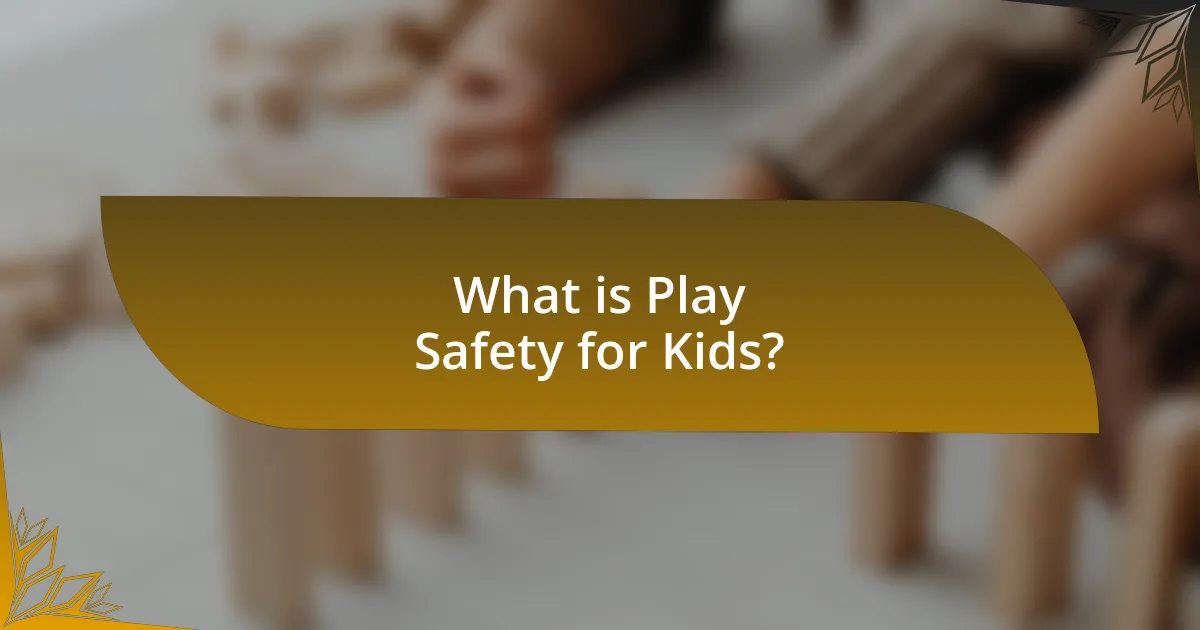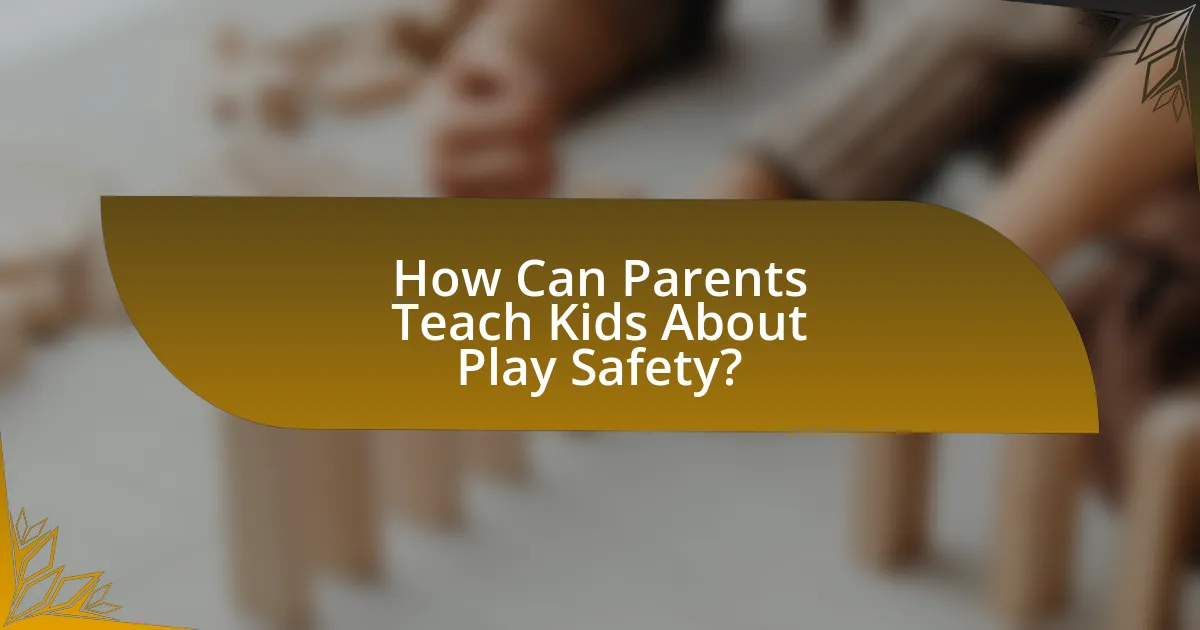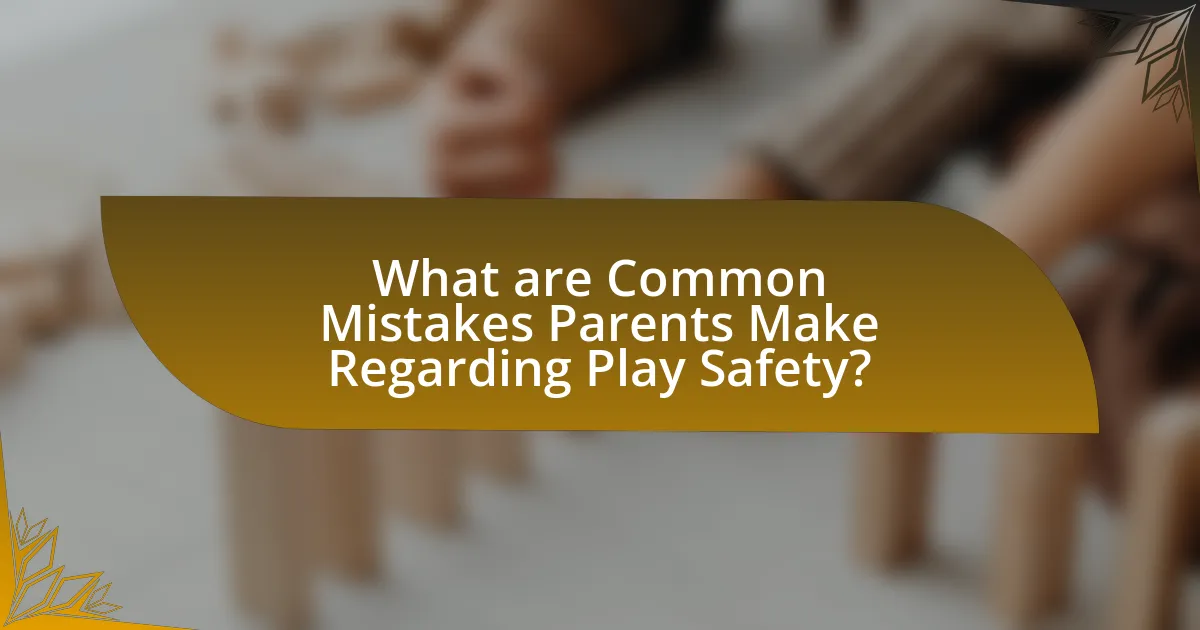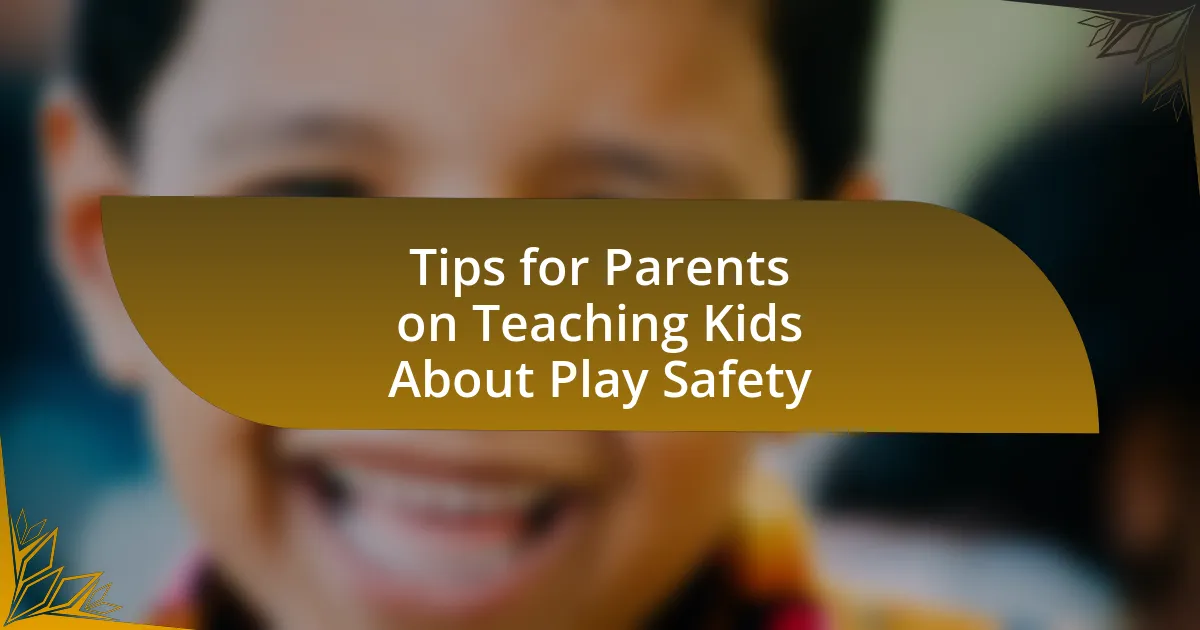Play safety for kids encompasses the practices and measures that ensure children can engage in play without the risk of injury or harm. This article outlines the importance of creating safe play environments, using age-appropriate toys, and providing supervision to prevent accidents, which are a leading cause of emergency room visits for children. It discusses the potential risks associated with play, the key components of play safety, and strategies parents can employ to educate their children about safe play practices. Additionally, the article highlights common mistakes parents make regarding play safety and offers practical tips for creating a secure play environment at home.

What is Play Safety for Kids?
Play safety for kids refers to the measures and practices that ensure children can engage in play activities without risk of injury or harm. This includes creating a safe environment, using age-appropriate toys, and supervising play to prevent accidents. According to the American Academy of Pediatrics, safe play environments significantly reduce the likelihood of injuries, which are a leading cause of emergency room visits for children.
Why is Play Safety Important for Children?
Play safety is crucial for children because it prevents injuries and promotes healthy development. Safe play environments reduce the risk of accidents, allowing children to explore, learn, and socialize without the threat of harm. According to the Centers for Disease Control and Prevention, over 200,000 children visit emergency rooms each year due to playground-related injuries, highlighting the importance of safety measures. Ensuring that play areas are well-maintained and age-appropriate can significantly decrease these incidents, fostering a secure space for children to engage in physical activity and imaginative play.
What are the potential risks associated with play?
The potential risks associated with play include physical injuries, psychological harm, and exposure to unsafe environments. Physical injuries can occur from falls, collisions, or improper use of equipment, with the Centers for Disease Control and Prevention reporting that over 200,000 children visit emergency rooms annually due to playground-related injuries. Psychological harm may arise from bullying or social exclusion during play, which can affect a child’s emotional well-being. Additionally, unsafe environments, such as poorly maintained play areas or hazardous materials, can lead to accidents or health issues. These risks highlight the importance of supervision and safety measures in play settings.
How can play safety prevent injuries?
Play safety can prevent injuries by ensuring that children engage in activities within a secure environment, using appropriate equipment, and following established safety guidelines. Implementing safety measures such as regular inspections of play areas, using age-appropriate toys, and teaching children safe play practices significantly reduces the risk of accidents. According to the Centers for Disease Control and Prevention, proper supervision and safety protocols can decrease playground injuries by up to 50%.
What are the key components of Play Safety?
The key components of play safety include supervision, safe play environments, age-appropriate activities, and proper equipment use. Supervision ensures that children are monitored during play to prevent accidents and injuries. Safe play environments involve checking for hazards such as sharp objects, unstable surfaces, or unsafe equipment. Age-appropriate activities are crucial as they match the developmental stages of children, reducing the risk of injury. Proper equipment use entails teaching children how to use playground equipment correctly to avoid falls and injuries. These components collectively contribute to a safer play experience for children.
What types of play environments require safety considerations?
Play environments that require safety considerations include playgrounds, parks, indoor play areas, and water play environments. These settings often contain equipment and features that can pose risks, such as swings, slides, climbing structures, and water bodies. For instance, the U.S. Consumer Product Safety Commission reports that over 200,000 children are treated for playground-related injuries annually, highlighting the need for safety measures in these environments. Additionally, indoor play areas may have unique hazards like crowded spaces and equipment that can lead to falls or collisions. Therefore, ensuring safety in these play environments is crucial to prevent injuries and promote a secure play experience for children.
How do age-appropriate activities influence play safety?
Age-appropriate activities significantly enhance play safety by ensuring that children engage in play that matches their developmental skills and physical abilities. When activities are tailored to a child’s age, they are less likely to encounter hazards that could lead to injuries. For instance, younger children benefit from supervised play with soft, safe materials, while older children can handle more complex equipment, reducing the risk of accidents. Research indicates that age-appropriate play reduces the likelihood of injuries; a study published in the Journal of Pediatric Health Care found that children participating in suitable activities experienced 30% fewer injuries compared to those engaged in inappropriate play. This correlation underscores the importance of selecting activities that align with a child’s developmental stage to promote a safer play environment.

How Can Parents Teach Kids About Play Safety?
Parents can teach kids about play safety by establishing clear rules and guidelines for safe play. This includes explaining the importance of using equipment properly, being aware of their surroundings, and understanding the potential risks associated with different play activities. For instance, parents can demonstrate how to use playground equipment safely, such as waiting their turn on slides and swings, which reduces the risk of accidents. Research shows that children who receive direct instruction on safety practices are more likely to engage in safe behaviors during playtime. Additionally, parents can reinforce safety messages through consistent reminders and discussions about safe play scenarios, helping children internalize these important lessons.
What strategies can parents use to educate their children?
Parents can educate their children about play safety by implementing clear communication, modeling safe behaviors, and establishing rules. Clear communication involves discussing the importance of safety in play, ensuring children understand potential hazards. Modeling safe behaviors means parents demonstrate how to engage in play safely, reinforcing lessons through their actions. Establishing rules provides a structured environment where children learn boundaries and safe practices, such as taking turns and using equipment properly. Research indicates that children who receive consistent safety education from parents are more likely to engage in safe play behaviors, reducing the risk of accidents.
How can parents model safe play behavior?
Parents can model safe play behavior by actively demonstrating safety practices during playtime. For instance, when engaging in outdoor activities, parents should wear appropriate safety gear, such as helmets and knee pads, and encourage their children to do the same. This not only shows children the importance of safety but also reinforces the idea that safety is a priority. Research indicates that children are more likely to adopt safe behaviors when they observe their parents practicing them, as modeling is a key component of social learning theory. By consistently prioritizing safety, parents can effectively instill these values in their children.
What role does communication play in teaching safety?
Communication is essential in teaching safety as it facilitates the clear exchange of information regarding potential hazards and safe practices. Effective communication ensures that children understand safety rules, recognize dangers, and can articulate their own safety concerns. Research indicates that children who engage in discussions about safety are more likely to remember and apply safety guidelines, as evidenced by a study published in the Journal of Safety Research, which found that interactive communication significantly improved children’s safety knowledge and behavior.
What resources are available for parents on play safety?
Parents can access various resources on play safety, including guidelines from the American Academy of Pediatrics, which offers comprehensive safety tips for children during play. Additionally, the Consumer Product Safety Commission provides safety standards and recalls for playground equipment, ensuring parents are informed about potential hazards. The National Program for Playground Safety also offers educational materials and training for parents to promote safe play environments. These resources collectively equip parents with the necessary information to ensure their children’s safety while playing.
Where can parents find safety guidelines for different play areas?
Parents can find safety guidelines for different play areas through resources such as the Consumer Product Safety Commission (CPSC) website, which provides comprehensive safety information on playground equipment and safety standards. Additionally, the National Association for the Education of Young Children (NAEYC) offers guidelines specifically tailored for early childhood settings. These organizations publish detailed recommendations and safety checklists that help ensure safe play environments for children.
How can community programs support parents in teaching play safety?
Community programs can support parents in teaching play safety by providing educational workshops and resources that focus on safe play practices. These programs often offer hands-on training sessions where parents learn about potential hazards and how to mitigate them, such as supervising children during play and selecting age-appropriate toys. Additionally, community initiatives may distribute informational materials, such as brochures or online resources, that outline safety guidelines and best practices for various play environments. Research indicates that parental involvement in safety education significantly reduces the risk of play-related injuries, highlighting the effectiveness of community support in enhancing parental knowledge and skills in this area.

What are Common Mistakes Parents Make Regarding Play Safety?
Common mistakes parents make regarding play safety include underestimating risks, failing to supervise adequately, and not teaching children about safe play practices. Parents often overlook potential hazards in play environments, such as sharp objects or unstable equipment, which can lead to injuries. Additionally, inadequate supervision can result in children engaging in unsafe behaviors, as they may not fully understand the risks involved. Research indicates that active supervision reduces the likelihood of accidents, emphasizing the importance of parental involvement during playtime. Furthermore, parents sometimes neglect to educate their children about safety rules, which is crucial for fostering awareness and responsibility in young play participants.
What misconceptions do parents have about play safety?
Parents often believe that all playground equipment is inherently safe, leading to a misconception that supervision is unnecessary. This belief can result in children being allowed to play unsupervised, increasing the risk of accidents. According to the U.S. Consumer Product Safety Commission, approximately 200,000 children are treated for playground-related injuries each year, highlighting the importance of active supervision. Additionally, some parents think that injuries only occur on traditional playgrounds, overlooking the fact that home play areas can also pose significant risks if not properly maintained. This misunderstanding can lead to inadequate safety measures being implemented in private play spaces.
How can overprotectiveness hinder a child’s understanding of safety?
Overprotectiveness can hinder a child’s understanding of safety by preventing them from experiencing and learning from real-life situations. When parents excessively shield their children from potential risks, the children miss opportunities to develop critical thinking and problem-solving skills related to safety. For instance, a study published in the Journal of Child Psychology and Psychiatry found that children who are allowed to engage in moderate risk-taking activities, such as climbing or exploring, develop better risk assessment abilities. This indicates that without exposure to manageable risks, children may struggle to recognize and respond appropriately to dangers in their environment.
What are the dangers of neglecting safety discussions?
Neglecting safety discussions can lead to increased risks of accidents and injuries among children during play. Without proper communication about safety protocols, children may engage in risky behaviors, such as climbing on unsafe structures or ignoring rules designed to protect them. Research indicates that environments lacking safety education can see a significant rise in injury rates; for instance, the American Academy of Pediatrics reported that unintentional injuries are the leading cause of death for children aged 1 to 4. Therefore, failing to prioritize safety discussions not only endangers children’s physical well-being but also undermines their ability to make informed decisions about their safety during play.
How can parents effectively address these mistakes?
Parents can effectively address mistakes related to play safety by implementing clear communication and consistent supervision. Establishing open dialogues about safety rules helps children understand the importance of safe play, while active monitoring ensures that parents can intervene when unsafe behaviors occur. Research indicates that children who receive consistent guidance from parents are more likely to engage in safe play practices, reducing the risk of accidents. For instance, a study published in the Journal of Safety Research found that parental involvement significantly decreases the likelihood of playground injuries among children.
What steps can parents take to improve their approach to play safety?
Parents can improve their approach to play safety by conducting regular safety checks of play areas. This involves inspecting equipment for hazards such as sharp edges, loose parts, or unstable structures, which can lead to injuries. According to the American Academy of Pediatrics, approximately 200,000 children are treated for playground-related injuries each year, highlighting the importance of proactive safety measures. Additionally, parents should educate their children about safe play practices, such as taking turns and using equipment as intended, to further reduce the risk of accidents.
How can parents encourage children to speak up about safety concerns?
Parents can encourage children to speak up about safety concerns by fostering an open and trusting communication environment. This can be achieved by actively listening to children, validating their feelings, and reassuring them that their concerns are important and will be taken seriously. Research indicates that children are more likely to report safety issues when they feel supported and safe in expressing their thoughts, as highlighted in studies on child psychology and communication. By regularly discussing safety topics and role-playing scenarios, parents can empower children to articulate their concerns effectively.
What are practical tips for ensuring play safety?
To ensure play safety, parents should supervise children during playtime, as active supervision significantly reduces the risk of accidents. Establishing clear rules about safe play, such as no pushing or roughhousing, helps children understand boundaries. Additionally, choosing age-appropriate toys and play equipment minimizes hazards; for instance, toys should be free of small parts that could pose choking risks for younger children. Regularly inspecting play areas for potential dangers, such as sharp objects or unstable surfaces, further enhances safety. According to the American Academy of Pediatrics, proper supervision and safe environments can prevent up to 80% of playground injuries.
How can parents create a safe play environment at home?
Parents can create a safe play environment at home by removing hazards and ensuring proper supervision. This involves securing heavy furniture to walls, using safety gates to block stairs, and keeping small objects out of reach to prevent choking. Additionally, parents should regularly inspect toys for damage and ensure they are age-appropriate, as studies show that 70% of toy-related injuries occur with toys not suited for the child’s age. Implementing these measures significantly reduces the risk of accidents and injuries during playtime.
What should parents teach children about recognizing hazards during play?
Parents should teach children to identify potential hazards during play, such as sharp objects, unstable surfaces, and unsafe play equipment. By encouraging children to assess their surroundings, parents can help them develop critical thinking skills necessary for recognizing dangers. Research indicates that children who are educated about safety are more likely to engage in safe play practices, reducing the risk of injury. For instance, a study published in the Journal of Safety Research found that children who received safety training demonstrated a 30% decrease in playground injuries.
